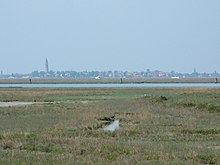Barena
A barena (often in the plural as barene ) is a form of salt marsh typical of the Venice lagoon . These are swampy areas that are regularly inundated by floods and form the border between the sea and the mainland. The lagoon itself already forms a transition between the mainland and salt water. The underlying Venetian word is baro , meaning bushes or bushes. The average height of the salt marshes above sea level is between 10 and 32 cm, with most being over 24 cm. They are mostly criss-crossed by natural canals, which in Venice are called ghebi (singular: ghebo ).
The Barene used to cover an area of more than 90 km² in the lagoon, today it is 47.5. Most of the marshes are in the northeast and southwest of the lagoon. Barene emerged mainly on the edges of the lagoon. Some are located at the former mouths of the rivers in the lagoon. There are also smaller bars on some canals and old bars that are now deeper under water or have been drained.
At high tide, the barene on the one hand reduce the impact of the waves, on the other hand they offer space for the water to penetrate the lagoon. In this way they relieve the populated areas, especially the old town and the more than 60 islands of the lagoon. However, they are endangered by the deepening of the canals and the harsh waves of the motor boats as well as sewage. When the city's canals were cleared of toxins, mud and algae in the 1990s , some of the mud was cleaned up and pumped into the barene to secure these erosion- endangered biotopes . In the meantime, however, the barene has been spared such attempts and flow-appropriate safeguards are being developed for the particularly endangered edges of the barene.

Only salt-tolerant plants can survive here. There are also numerous species of birds that rely on this type of salt marsh.
The counterpart to the often flooded Barene are the Velme , shallows that bear no vegetation because they only appear when the water level is very low.
literature
- L. Bonometto: Functional characteristics of salt marshes (barene) in the Venice Lagoon and environmental restoration scenarios , in: Caroline Fletcher, Tom Spencer (Eds.): Flooding and Environmental Challenges for Venice and its Lagoon. State of Knowledge , Cambridge University Press 2005, pp. 473-486.
- Maurizio Bonardi: Studio dei processi evolutivi di alcune barene della Laguna di Venezia (Bacino Nord) in relazione alle variazioni del livello marino , Venice 1996.
- Nicolò Spada: L'erosione delle barene nella laguna di Venezia nel secolo XVI , in: Archivio Veneto , ser. V, 50-51 (1952) 11-13.
Web links
- Laguna, il sistema Acqua , Venezia in Vela
supporting documents
- ↑ barene, velme e fondali . ( Memento from July 31, 2013 in the Internet Archive ) Sal.Ve
- ↑ Salt marsh vegetation promotes efficient tidal channel networks , Nature, July 19, 2016.

